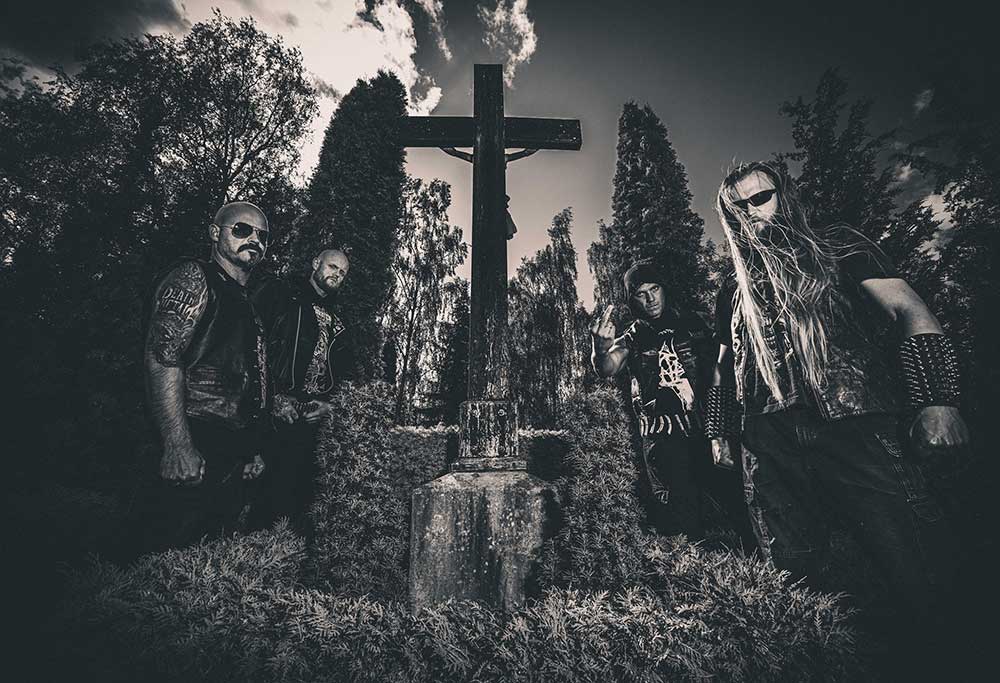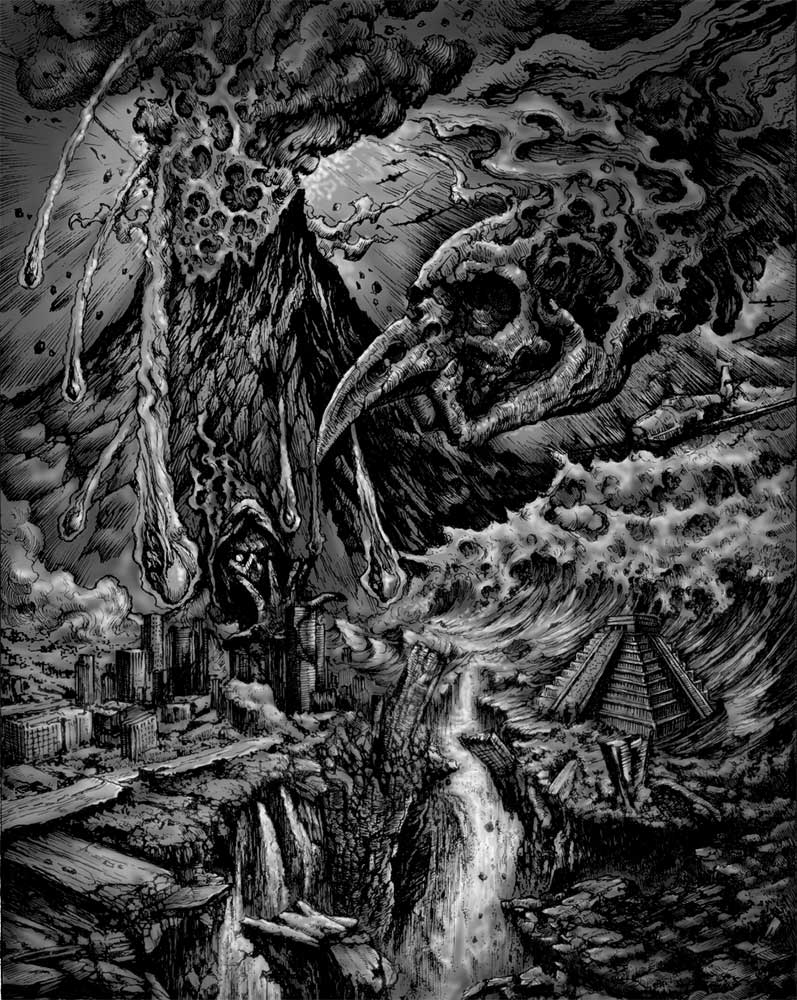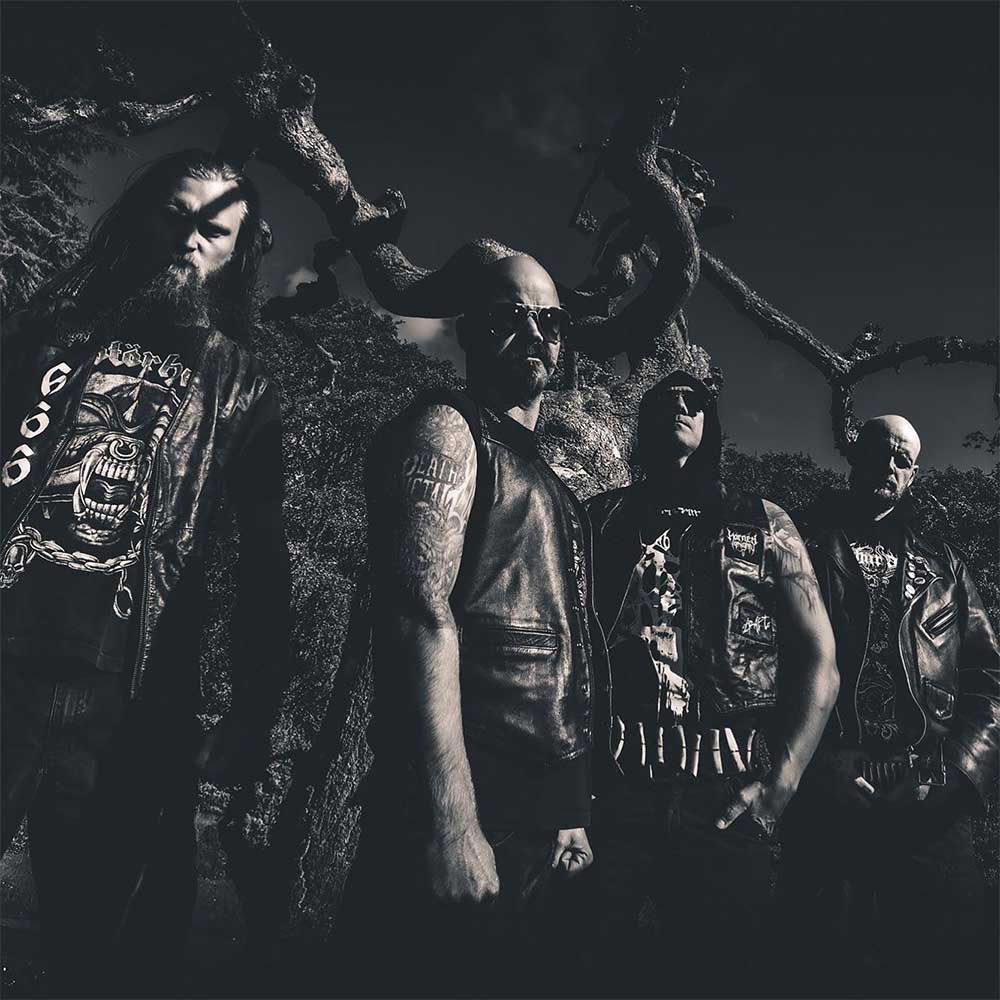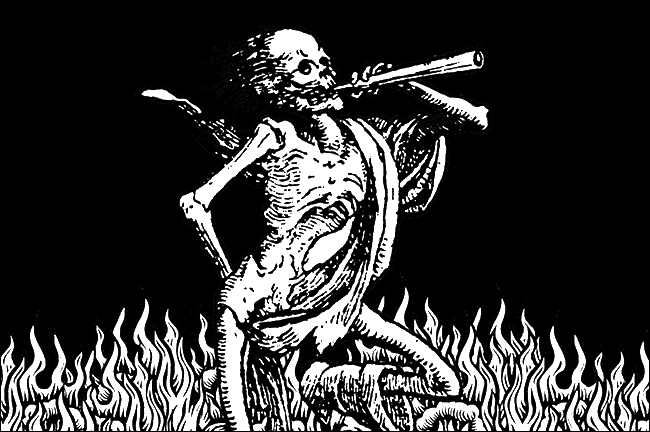Horned Almighty
2020-02-05
by Niklas Göransson
Unorthodox bass-work and humanoid eradication – Guitar player Hellpig and vocalist S of Danish veterans Horned Almighty discuss the musical and conceptual essence of their new album, To Fathom the Master’s Grand Design.
– We spent about four and a half years writing for this album, says Hellpig. Something that became apparent at an early stage was the need to mix things up this time around, to keep it interesting for ourselves. This was extremely liberating but also difficult, as we had a rather conservative preconception of what this band is supposed to sound like. So, we expanded the narrow confines of our soundscape and tried out things we’d never done before; the result is longer pieces with more complex and non-traditional arrangements, as well as an influx of sounds we wouldn’t have touched with a ten-foot pole a decade ago. Another thing we’ve been messing around with, most noticeable in the song “Swallowed by the Earth”, is using the same ostinato – a recurring melodic phrase – for various purposes, performed on different instruments and with contrasting themes on top or underneath which adds a lot of flavour to the dynamic.
Hellpig mentions that after surveying the first batch of reviews for “To Fathom the Master’s Grand Design”, it’s become apparent that what feels like a significant leap in style progression to the band is more akin to baby steps in the ears of the younger generation.
– Look, our style is so firmly rooted in ’old’ metal that no matter how much we try to evolve, we’re always gonna come across like a mixture of late-80s to mid-90s black and death metal; and we’re perfectly fine with this. At the end of the day, it all comes down to great and memorable riffs, vocal lines, and drum patterns – and, as I personally see it, we have all that. The recording process was approached with our usual modus operandi of ’let’s get this over with’; the actual tracking was done in a total of twenty hours, I think. The first day was spent setting up and then recording all drums and bass lines, and on day two we recorded guitars and then vocals in two separate four-hour sessions. No click tracks, no triggers, no amp-sims – just loud drums, loud amps, and full takes – engineered, mixed, and mastered by our long-time friend and former guitarist, Quentin Nicollet. Quentin has engineered all our albums since the 2006 “The Devil’s Music”, but this was his debut of also mixing and mastering for us and the result is outstanding. This is how we’ve always strived to do things, making our records sound like live-albums, and it really makes for an end result that’s very honest, spontaneous, and, in our case, violent and full of urgency. Is it flawless? Hell no. Is it phrenetic? You bet.

I noticed that the promo sheet mentions HORNED ALMIGHTY as ‘extreme metal’, which set off immediate alarm bells. I was under the impression that they were a black metal band with influences from other genres. As everyone knows, veteran bands changing their genre affiliation is often a strong warning sign that something is amiss – much like the dreaded logo change.
– Ah, yes, the logo change; IMMORTAL springs to mind as a prime example of this. As for the genre definition in the promo sheet… I suppose the label came up with that, because we sure as hell didn’t. We always considered our music deeply rooted in black metal, or proto-black metal, both in terms of musical output and visual aesthetic but with a lot of other elements thrown in for good measure. We’ve been at this for so long by now – almost two decades as HORNED ALMIGHTY, and before that five years with S and my previous band, MARERIDT – so it would be strange if the flavour of the music we write hadn’t changed over the course of time. However, I think we’ve stayed pretty true to what this band was all about since the very beginning. In my opinion, changing things around too much under the same moniker rarely works; people have a certain set of expectations when they pick up an album with MARDUK, AC/DC, or perhaps even HORNED ALMIGHTY, but throwing the occasional curveball or two keeps things interesting for both musician and listener.
Further inspecting said promo sheet, the ‘For fans of CELTIC FROST, MOTÖRHEAD, MAYHEM, AUTOPSY” guidelines were actually rather apt. The drums have a punkish feel and much of the bass sounds like a blend between Lemmy and old-school death metal. Also, that bass-work towards the end of “Punishment Divine” is pretty neat.
– Those references are to a large extent a summary of the things we hear in our own music, meant to give the prospective listener an idea about what kind of barrage they’re getting themselves into. The bass has always been prominent in our sound, delivering this tractor-like low-end growl, highly inspired by MOTÖRHEAD but also the clunky bass found on the likes of “Severed Survival” by AUTOPSY, ”Black Shining Leather” by CARPATHIAN FOREST, and even the unorthodox bass playing on old NECROMANTIA. However, the role of this instrument in our music changed around 2009 when we found ourselves without a bass player for a while. We were determined to continue as a four-piece, so I switched to bass for several years. On the early albums, harmonies and layers were primarily done using dual guitars – a lot of that wasn’t possible anymore so we transferred quite a few guitar riffs to the bass. This way, we were able to pull the old songs off live while still retaining the harmonic layers. This approach also influenced the song-writing on the next album, “Necro Spirituals” (2010) quite a bit. Listen closely and you’ll note how the guitar and bass are doing very different things a lot of the time – resulting in a way denser soundscape compared to if everything was just in unison. Consequently, for the last decade or so, we’ve shared the lead parts between bass and guitar, and the part you reference is a good example of the bass taking the lead. We use the tools at hand and make the most of them.

To aid my preparations for this conversation, Hellpig sent me a number of past HORNED ALMIGHTY interviews – one of them stemming from a 2010 issue of Norwegian black metal magazine Nordic Vision. I actually had not the slightest clue the publication survived that long; I loved those mid-90s issues but stopped buying it around the time they began featuring metal models.
– Nordic Vision was on hiatus from somewhere around 2000ish, but then resurfaced in 2009 and released another four or five issues. Nordic Vision was one of the few magazines I picked up on a regular basis in the mid-to-late 90s, before the internet really caught on. They featured a lot of the bands I was personally interested in at the time, and the editor was just ruthless – slaughtering eighty percent of all demos and albums in his reviews. So, it was with some trepidation we sent them the MARERIDT demo in late 1996… and, sure enough, we got the full Nordic Vision treatment, being completely run over by the editor. That was somewhat expected but not everyone had the backbone to accept his harsh reviews and sarcastic tone, leading to several funny confrontations between the editor and a few different bands; a certain unnamed Israeli act comes to mind. Anyway, when Nordic Vision got in touch between the release of our 2009 album, “Contaminating the Divine”, and “Necro Spirituals”, it was a really nice blast from the past and they actually showed genuine interest in the band and our music.
What do you think of the current state of affairs in underground media?
– I think laziness is the keyword here, unfortunately. More often than not, the standard interview – especially with webzines – consists of a template of ten to twelve generic questions in random order which don’t seem to address any band in particular. When the interviewer is lazy, the interviewee also gets lazy and the end result is just horrible, boring crap. If the ’journalist’ doesn’t give a shit, then why should I? The same goes for reviews… if you’re not willing to put in the effort and really delve into the album you’re supposed to review, and at least try to formulate a cohesive block of text, how the hell can you expect anyone to spend even a minute of their time reading your randomised rambling? Fortunately, there are exceptions to the rule in both cases. But most of the printed magazines that were worth anything are long gone anyway: Nordic Vision, Terrorizer, Slayer Mag, Iron Fist, and so on. Zero Tolerance seems to be one of the only ones still alive and kicking.
– Social media has increased the amount of available news platforms, adds vocalist S, which means that practically anyone can be a reporter or reviewer nowadays. This is, by definition, true underground press but it also incites wannabee-journalists to inflict upon the world their lack of both experience and capabilities – not unlike all these ‘Instagram models’. When diving into an interview, it doesn’t take long to see whether there’s an actual interest in your art and how you wish to portray it. Most often we receive the standardised versions, which includes questions answered a million times before. But it’s a part of the game and we accept these terms, since it lies in our own interest as well.
I read in another interview that the new material was written over a period of several years, ‘sometimes to the point of existential doubt’ – is that to say you were ever at the point of giving up?
– No, says Hellpig, I never considered quitting, but the process just dragged on for so long that we wondered if we were ever going to be able to finish it. Ultimately, what helped was actually setting a deadline and picking a date for when to start recording. The last song to be completed, “Violent Cosmology”, ended up the album opener; I finished the demo for that one at 4:30 in the morning on the day of our last rehearsal, four days prior to entering the studio. Pressure obviously has its advantages, ‘cause that track came out angry as hell. With the exception of two songs, for the past eighteen years we’ve always created and arranged our music as a unit in the rehearsal room. But once life catches up with you and you face the responsibilities of grown-up life, with all that this entails, it becomes increasingly difficult to meet up as often as when you were twenty or even thirty. So, that naturally prolonged the actual writing process quite a bit but, in the end, through perseverance and good old stubbornness, we prevailed.
– One of our primary strengths is that we have no obligations besides those to each other, adds S. Three of us have been a part of the cult since its conception nearly twenty years ago and there’s more than just music between us. Although frustrating at times, it was the acceptance of reality which essentially cleared us through the obstacles. A lot of things happened in our personal lives during the course of the last five years – much of which required full attention – but, unfortunately, not at the same time, resulting in many breaks during the writing of the album. We’d begin working on an idea but then, suddenly, several months had passed before we could continue; and, by then, the essential inspiration had been lost. A lot of material was discarded over the years. The process of finishing the songs was excruciating and it took a long time before we could actually envision the album in its entirety. The feeling of just simply quitting occurred more than once for my part, but this would’ve been a huge personal mistake since I’d already spent a lot of time researching the album concept. Discarding this was simply not an option.

The theme of “To Fathom the Master’s Grand Design” is the annihilation of the human race, documented throughout various historical cataclysmic events which brought about the death of millions.
– Through the violent and unrelenting powers of nature, or the mere will of man himself, history has repeatedly shown that evil exists on many levels and manifests through many, seemingly unrelated, occurrences The thesis is to prove through historical documentation the existence of a higher force pursuing the death of man, and to offer insight to such tremendous events of cruelty and demise. This grand design is the unavoidable fate of mankind and consolidates deities, nature, and death itself into one multifaceted Master – one who’s been given many names throughout the existence of man, as all ancient religions had one or several death deities. Adapted to a larger objective, it’s all combined into that very goal. From the single personal human decision to commit murder to the vast magnitudes of an earthquake, both events are cruel and evil in human terms; hard to grasp and comprehend. The grand design is inevitable for all of us, no matter which codes or beliefs you follow.
What initially set off the chain of thought which landed S in the album’s thematic content was reading about the 1815 eruption of Mount Tambora on an island outside Indonesia. After about a week of rumbling, April 10 saw the volcano vomit forth three fiery columns into the sky and heaving vast amounts of dust, rocks, and gas into the atmosphere. Fire-spawned winds levelled forests to the ground and pyroclastic flows – clouds of volcanic matter and hot gas – came rushing down the mountain at almost two hundred kilometres per hour, instantly vaporising somewhere in the range of 10,000 islanders. However, this is nothing compared to what followed in its wake.
– The eruption resulted in worldwide weather disasters due to contents shot into the atmosphere. Ash-clouds circled the planet and sabotaged the global climate system, leading to a series of catastrophic events. Famine, floods and drought caused millions to succumb. It inspired me to delve deeper into the matter of natural disasters, both as single events but also in general. The death tolls were spectacular – not only in the past but also to this present day. Just the 2004 Indian Ocean earthquake and resulting tsunami claimed the lives of an estimated 228,000 people and the Haiti earthquake in 2010 about 230.000. Not quite in the same range of casualties as Tambora, but the scale is still as massive as it is incomprehensible. Each such event also changes the livelihoods for thousands of people, resulting in additional casualties on a long-term basis. Right now, as this conversation takes place, the Taal volcano in the Philippines is spewing ash and warns of an explosive eruption, followed by the possibility of tsunamis. Close to a million people are being evacuated. The violent forces of nature are constant, and I can only imagine they will be increasing with the escalating climate changes. After reading about the eruption of Tambora and the vast effects which followed, the theory of similar intertwined events emerged. Not unlike chaos theory, where seemingly separate and independent incidents are connected.

Mount Tambora is explored in “Apocalyptic Wrath”, what other events did you write about?
– The first major event that came to mind was the Black Death, which lasted from 1346 to 1353 and resulted in deaths estimated up to two-hundred million, about sixty percent of Europe’s population. At the time, such a vast pandemic must’ve seemed like judgement day and has since become an important part of especially European history. This became the foundation for “The Great Death”, which describes the plague spreading from its epicentre in the Gobi Desert to the rest of the world. Along with the change of many social structures after the plague, an interesting fact is that the event also birthed some of the earliest known incarnations of biological warfare.
This might actually be how the bubonic plague first ended up in mainland Europe. In 1347, the Mongol army had besieged Kaffa, a city in contemporary Crimea, and begun catapulting expired plague victims over the walls. Not only did they spread the Black Death amongst the city’s residents, Genoese traders fleeing the town by sea brought it along with them to Sicily. Two years later, it had travelled all the way across the continent and reached Scandinavia.
– In its aftermath, the clergy explained the pandemic as the wrath of God. Consequently, all sins capable of inciting divine anger were to be rooted out; homosexuals, prostitutes, and people of other beliefs than Christianity became scapegoats and were persecuted and killed. Especially the Jewish communities were targeted, and a series of pogroms and massacres followed. Whilst not intentionally part of the concept, these historical mass-persecutions inspired “Punishment Divine”. Not all inspiration came from single events though, for example, the struggle between men is an unavoidable factor in the history of humanity. Unable to settle for a single event, “Antagonism Eternal” is a general description of war and the carnage that follows. Natural disasters return as a theme in “Swallowed by the Earth”, which explores the mass-scale destruction of earthquakes whereas “Devouring Armageddon” describes the immense and ravaging tsunamis. Nature often proves to be mankind’s worst enemy…
It’s interesting to ponder that no matter how scientifically advanced, powerful, and militarily capable an empire grows, nature can easily administer a full civilisational reset by the smallest shrug. Consider a comparably small solar flare like the 1859 Carrington Event – which was powerful enough to super-charge telegraph machines, shooting sparks which lit houses on fire and electrocuted operators unfortunate enough to be using them – imagine something like that in a contemporary society, where electricity is literally built into our infrastructure.
– It is indeed ironic how frail and fragile humanity has become with the progress of technology. Some of the most ancient drawings of man depict hunters charging large beasts with spears – contemporary art would instead see man wielding an iPhone, battling strangers on social media. We depend on modern technology to a point of false security, which leaves us content and ignorant. Natural disasters like those witnessed in the past still bring chaos and destruction to this day, despite technological advancements. For example, Atlantic hurricanes and large-scale forest fires appear to increase in numbers and create more damage than ever, due to the ever-growing expansion of mankind. Although modern medicine has long invented cures for diseases which caused worldwide pandemics in the past, novel multi-resistant bacteria develops every day. A new disease, called the corona virus, is spreading from China as we speak. Believed by WHO to be from the same viral string as SARS and MERS, casualties have already occurred. There is a fundamental and consistent will within the powers of nature to destroy man and there are no definitive solutions in the long run, because death is inevitable for all. With a population now nearing eight billion, there are many chapters yet to be written…



